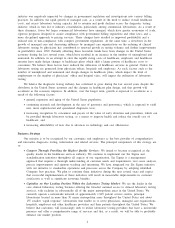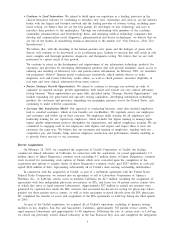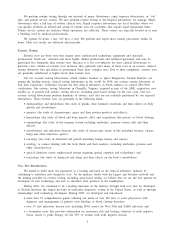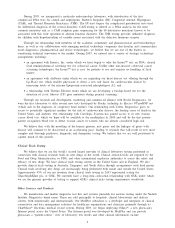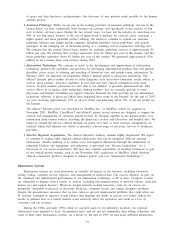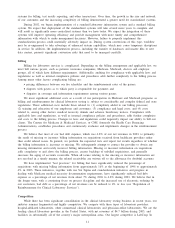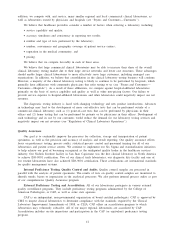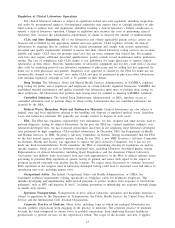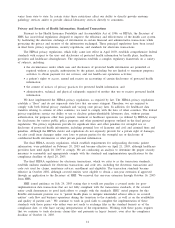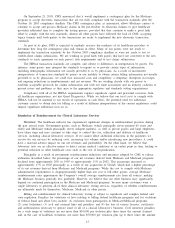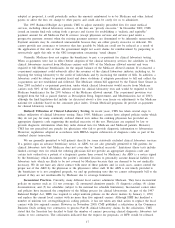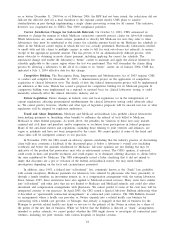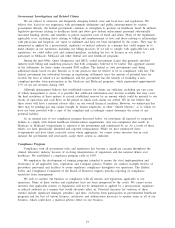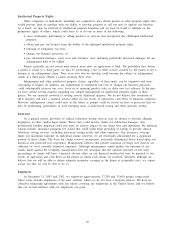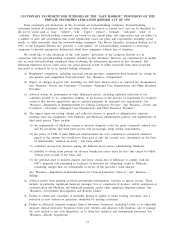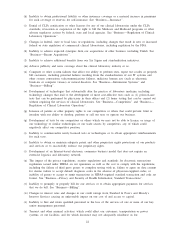Quest Diagnostics 2003 Annual Report Download - page 29
Download and view the complete annual report
Please find page 29 of the 2003 Quest Diagnostics annual report below. You can navigate through the pages in the report by either clicking on the pages listed below, or by using the keyword search tool below to find specific information within the annual report.addition, we compete with, and service, many smaller regional and local commercial clinical laboratories, as
well as laboratories owned by physicians and hospitals (see “Payers and Customers—Customers’’).
We believe that healthcare providers consider a number of factors when selecting a laboratory, including:
•service capability and quality;
•accuracy, timeliness and consistency in reporting test results;
•number and type of tests performed by the laboratory;
•number, convenience and geographic coverage of patient service centers;
•reputation in the medical community; and
•pricing.
We believe that we compete favorably in each of these areas.
We believe that large commercial clinical laboratories may be able to increase their share of the overall
clinical laboratory testing market due to their large service networks and lower cost structures. These advantages
should enable larger clinical laboratories to more effectively serve large customers, including managed care
organizations. In addition, we believe that consolidation in the clinical laboratory testing business will continue.
However, a majority of the clinical laboratory testing is likely to continue to be performed by hospitals, which
generally have affiliations with community physicians that refer testing to us (see “Payers and Customers—
Customers—Hospitals’’). As a result of these affiliations, we compete against hospital-affiliated laboratories
primarily on the basis of service capability and quality as well as other non-pricing factors. Our failure to
provide service superior to hospital-affiliated laboratories and other laboratories could negatively impact our net
revenues.
The diagnostic testing industry is faced with changing technology and new product introductions. Advances
in technology may lead to the development of more cost-effective tests that can be performed outside of a
commercial clinical laboratory such as (1) point-of-care tests that can be performed by physicians in their
offices and (2) home testing that can be performed by patients or by physicians in their offices. Development of
such technology and its use by our customers would reduce the demand for our laboratory testing services and
negatively impact our net revenues (see “Regulation of Clinical Laboratory Operations’’).
Quality Assurance
Our goal is to continually improve the processes for collection, storage and transportation of patient
specimens, as well as the precision and accuracy of analysis and result reporting. Our quality assurance efforts
focus on proficiency testing, process audits, statistical process control and personnel training for all of our
laboratories and patient service centers. We continue to implement our Six Sigma and standardization initiatives
to help achieve our goal of becoming recognized as the undisputed quality leader in the healthcare services
industry. Our Nichols Institute facility in San Juan Capistrano was the first clinical laboratory in North America
to achieve ISO-9001 certification. Two of our clinical trials laboratories, our diagnostic kits facility and one of
our routine laboratories have also achieved ISO-9001 certification. These certifications are international standards
for quality management systems.
Internal Proficiency Testing, Quality Control and Audits. Quality control samples are processed in
parallel with the analysis of patient specimens. The results of tests on quality control samples are monitored to
identify trends, biases or imprecision in the analytical processes. We also perform internal process audits as part
of our comprehensive Quality Assurance program.
External Proficiency Testing and Accreditation. All of our laboratories participate in various external
quality surveillance programs. They include proficiency testing programs administered by the College of
American Pathologists, or CAP, as well as some state agencies.
CAP is an independent, non-governmental organization of board certified pathologists. CAP is approved by
CMS to inspect clinical laboratories to determine compliance with the standards required by the Clinical
Laboratory Improvement Amendments of 1988, or CLIA. CAP offers an accreditation program to which
laboratories may voluntarily subscribe. All of our major regional laboratories are accredited by CAP.
Accreditation includes on-site inspections and participation in the CAP (or equivalent) proficiency testing
program.
12


